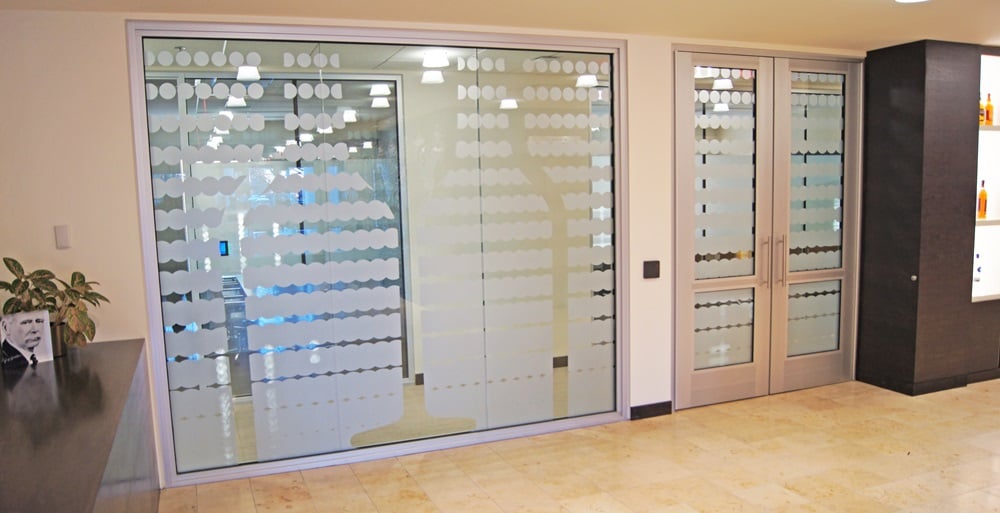In general, you have just as many options with ballistic security glazing as you do with standard window glazing. Total Security Solutions can get you what you need at whatever security level you want.
Bullet-resistant windows are made of solid acrylic glazing, laminated polycarbonate glazing, or glass-clad polycarbonate (GCP). Laminated polycarbonate and GCP are made of fused layers of acrylic, polycarbonate, glass, and other materials. Because we fabricate our ballistic glazing in-house, we are able to create highly-customized bulletproof glass barriers that not only stop bullets but look great, too. This includes many different unique or specialty treatments.
In this blog, we’ll discuss the different customization options for bulletproof glass products.
Tinted Bulletproof Windows for Buildings
Tinted glass is made by adding coloring minerals to the raw materials before heating and forming. Since bullet-resistant GCP includes glass layers, GCP can be tinted using standard window tint colors.We simply include a thin glass interlayer of your desired color during production, fusing it into your sheet of GCP. If you are looking for an acrylic or polycarbonate bulletproof glass window in a specific tint, please reach out to us to learn more about your options.
Is Bulletproof Glass Tinted Already?
No. However, different kinds of ballistic windows sometimes appear to have a slight blue-green tint. This is normal for very thick ballistic glass products. You may also notice slight variations between pieces of glazing in certain lighting. Any slight differences occur naturally and are the result of the process of layering the glass and plastics used to make the ballistic windows.
Mirrored Bullet-Resistant Glass
When you need to create mirrored bulletproof glass, the process is similar to color tinting. We typically include a semi-silvered glass interlayer in the makeup of your bullet-resistant GCP glazing to achieve a mirrored effect.
Frosted Bullet-Resistant Glass
There are several ways to create frosted bullet-resistant windows. For longer-lasting, better-looking windows, we prefer using GCP with an interlayer of frosted glass. For situations where a project must use acrylic ballistic glazing, we can make frosted ballistic acrylic panes using TSS’s custom surface treatment.
Low-E Ballistic Glazing
Low-E (low emissivity) coating makes windows more energy efficient. The coating allows light to pass through the window, but not heat. This keeps the warm air inside in the winter and outside in the summer.
Like mirrored and tinted windows, low-e windows require a genuine glass layer in your ballistic window. This is accomplished with a transparent layer of metal oxide added to the glass. It’s best for this coating to be applied when the glass is made, after forming but while the glass is still hot. Applying the coating at this point ensures that the coating fuses to the glass itself, making Low-E an option available with any GCP glazing.
Insulated Ballistic Glazing
Insulated glass is standard in commercial construction, but wasn’t an option for bulletproof windows until recently. Over the last several years, TSS has worked hard to improve the insulation of exterior bulletproof windows; our product offerings are a variety of GCP products. We developed the industry’s first true ballistically rated thermal-break window framing system (the TSS-650 Thermal Framing System). Today TSS offers a wide range of insulated bulletproof windows.
“Low-Spall” and “No-Spall” Bulletproof Windows
Spalling is unique to ballistic and security glazing. When a bullet or other high-speed object hits a bulletproof window on its “threat side,” the force of the impact can cause glazing fragments called spall to burst from the surface of the “secure side.” The window can withstand the force of the shot and stop the bullet, but the spall might still pose a risk to people or sensitive items on the other side of the barrier. The answer to this problem is a “no-spall” glazing option.
Some ballistic glazing—like acrylic or certain laminated polycarbonate makeups—are always no-spall. Others, like GCP, are low-spall; they emit some fragments upon contact, but not nearly as much as standard glass. There is a no-spall option for GCP. No-spall ballistic GCP glazing includes a polycarbonate layer on the secure side. This flexes when an object strikes it, so the window remains intact. It creates no spall or other fragments, no matter how hard that window is hit.
Get Started on Your Custom Ballistic Glazing Project Today
Ready to learn more about your ballistic glazing options? Download TSS’s free Ballistic Glazing Solutions Guide today. This guide breaks down everything you need to know about ballistic glazing, including protection levels, the four types of glazing, and design features and considerations. It’s a valuable resource for anyone considering a bulletproof glass project; get started by downloading today.

